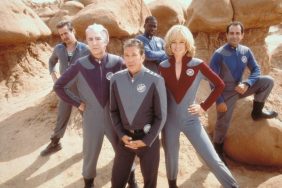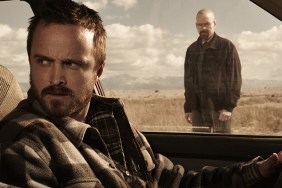Fred Topel, taking a brief break, has been kind enough to hand over the next six weeks of Best Episode Ever to Witney Seibold, CraveOnline‘s resident Trekkie, so that he may examine each of the franchise’s high points.
My qualifications: I started watching reruns of the original “Star Trek” when I was a child. I love “Star Trek: The Next Generation.” I went to several “Star Trek” conventions, way before geek was cool. I read “Star Trek” novels, played the video games (note: There are no good “Star Trek” video games. None), put together models, and even owned a DS9-era science officer’s uniform. I had an Enterprise wall-hanging. I have an opinion on the “Trekkie vs. Trekker” debate (Trekkie is the proper term, sir; “Trekker” smacks of geek denial). In short: I am an old-school Trek nerd. I know what I’m talking about.
What kind of introduction can one give to Gene Roddenberry’s iconic 1966 television series “Star Trek?” This is a TV show so popular, so ubiquitous, so iconic, that even the very few people on this planet who have never seen an episode know its characters, settings, and technologies. It has had a profound influence not just on every facet of sci-fi and popular culture, but actual technology and science. Do you think you would have an iPad or a telephone in your pocket right now if those things hadn’t first appeared on “Star Trek?” We’re working on holograms, so it means holodecks aren’t far behind. Although we still need transporters. Someone get on that.

Despite all the positive and undeniable influences “Star Trek” has had on the world, there is one important fact we all must remember when talking about the show itself: It’s a pretty damn corny TV show. And while “Star Trek” presented us with a future of tech-positivity (no matter what technologies we invent, and no matter how far we travel into space, we will still be asking the same fundamental philosophical questions about what it is to be human), and it presented a futuristic idyll of peace and harmony (all war is perhaps at an end, and all humanity now lives in union), we have to admit that the show is undeniably hammy, and is most certainly dated; Roddenberry’s hippie-fied episodes about utopian free-love cult communes are especially jarring to modern audiences.
So when trying to pick out a best episode for “Star Trek,” you must realize that perhaps more than half of the episodes are instantly disqualified because, well, they’re not that great. We all remember episodes like “Mirror, Mirror,” “The Squire of Gothos,” and “The Naked Time,” but how often do you think about, say “Operation, Annihilate!,” or “For the World Is Hollow and I Have Touched the Sky?” And how many episodes have plots that hinge on Captain Kirk’s ability to seduce a female captor? It’s especially embarrassing and even a little bit uncomfortable when Kirk has to sexually awaken a 12-year-old girl to escape her clutches (seriously, watch “Miri” again).
Of the 76 episodes of the show, there are perhaps 25 to 30 good ones. And while it was easy to “narrow the field” when selecting the greatest, finding a single capital-B best episode was tough. I wish I could include some of my favorites here, but some of my favorites are most certainly not the best. “The Squire of Gothos” is energetic and fun, and even connects with the Next Generation-introduced Q Continuum in fan’s minds (yes, I read Peter David’s Q-Squared). Like everyone, I love “Mirror, Mirror,” and I even have soft spots for “Catspaw” and “Devil in the Dark.”

But that was just me pussyfooting around the obvious. I’m sorry to skew directly toward it again, but, as popular consensus constantly iterates, “The City on the Edge of Forever” is still the best “Star Trek” episode. I realize that saying this is like picking The Beatles as the world’s best rock band, or Citizen Kane as the world’s best movie. It may be true, but it’s so obvious. But, honestly, this is not a popular claim I can contest.
“The City on the Edge of Forever” was the second-to-last episode of “Star Trek’s” first season. It aired on April 6th, 1967. The teleplay was by Harlan Ellison, and I won’t get into the infamous authorial debate here.

The story: When Dr. McCoy (DeForest Kelley) accidentally gives himself a drug injection, he flees to the Enterprise’s transporter, beaming down to the surface of the nearest planet. Kirk (William Shatner) and Spock (Leonard Nimoy) beam down after him, only to be confronted with an eerie talking stone archway calling itself The Guardian of Forever. This being exists outside of time, and can transport anyone to any time. McCoy escapes through the portal, which instantly damages all of spacetime, obliterating the Enterprise, and indeed the entire Federation. Protected by their proximity to the Guardian, Kirk and Spock resolve to enter through the portal to retrieve McCoy and restore all of history.
Time travel stories are hard to do correctly. It take a certain finesse to ease out the obvious causal paradoxes that are an unfortunately inescapable facet of the form. That said, I admit that I love time travel stories, especially ones that deal directly with causality. Causality is a scientific theory that is wonderful to ponder, and thinking of the “could-have-beens” can spark all manner of playful debate. So we’re already dealing with a tricky and thoughtful story. We have to investigate what McCoy did to so rupture history, somehow undo it, and return to our time, hoping it was in tact. You’ll find that “could-have-beens” and causality fill feature heavily in most of my “Star Trek” picks.

All of a time travel investigation would make for a fine episode as is, we also have thrown into the mix one of the most heartbreaking love stories that “Star Trek” has ever dared. Kirk and spock find themselves in the 1930s on Earth, and they must blend in. They have have actually landed on Earth before McCoy landed there, so they have some time to kill (time travel can work that way). Kirk falls in love with Joan Collins, a benevolent and good-hearted pacifist who seems to represent all that is good in the “Star Trek” universe. Collin’s Edith Keeler is calm, resolute, devoted wholly to peace, and open to romance. She is the opposite of the kiss-’em-and-leave-’em aliens that Kirk has previously dealt with. She is alluring and lovable.
And she is destined to die. Spock, using a few futuristic widgets, learns that Edith is actually the key element in altering history. If she lives, she will start an entire pacifism movement in America. This will change the public’s opinion on World War II, delaying the U.S.’s intervention. Which will give Nazi Germany enough time to develop a nuclear bomb. Hence, no peace, no survival, no American space program, no Federation, no Starfleet. Kirk, deeply in love, realizes that McCoy must have saved her, and his mission is to stop McCoy, to allow her death to occur.

This is emotionally complex meat from a character we often associate with brashness, seduction, and righteous blustering violence (“We come in peace! Shoot to kill!”). Shatner pulls out all the stops, and gives a nuanced and subtle performance. We actually feel for Kirk in a new way. We see him as a man capable of heartbreak. Being the captain of a starship makes one aloof and perhaps lonely. We see now that Kirk is destined to be alone. Love and marriage just may not be viable options for him. We see a tragic side of Kirk we don’t usually see. This makes him richer and more complex.
But, more than that, “The City on the Edge of Forever” touches on some deeper themes of destiny. Sometimes, in our more self-indulgent existential crises, ask what the purpose of pain, war, and iniquity are. Why doesn’t peace win out, we cry? Why did so much suffering happen? “The City on the Edge of Forever” actually makes a painful case for WWII happening the way it did. Millions upon millions died, and we saw the face of human evil in an era when we were supposed to be enlightened. But maybe, just maybe, better things will come from it. History is a fickle animal, and sometimes it sacrifices millions for the eventual greater good. Yes, this is a TV episode that posits that WWII was cosmic order raising its head, and that even stanch pacifism may sometimes fail for a reason. Captain Kirk, then, had to break his own heart, and allow World War II to progress as it did in history books… just to do the right thing. Heavy.
A story of loss, war, and failure that is ultimately hopeful and triumphant. If not sad and tragic.
So yes, “The City on the Edge of Forever” is the obvious choice, but it is still the best one. It’s a thoughtful and complex episode, and perhaps codifies the best of the “Star Trek” universe: A sci-fi show known for its philosophy over simplicity, and sacrifice over violence.
Witney Seibold is a featured contributor on the CraveOnline Film Channel, and co-host of The B-Movies Podcast. You can read his weekly articles Trolling, Free Film School and The Series Project, and follow him on “Twitter” at @WitneySeibold, where he is slowly losing his mind.








